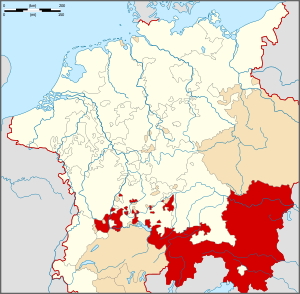Friuli
| Friuli Friûl (friulian) | |
|---|---|
| Historical region | |
|
Historical Flag of Friuli | |
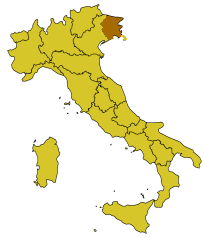 Location of Friuli in Italy | |
| Country | Italy |
| Region | Friuli-Venezia Giulia, Veneto |
| Area | |
| • Total | 8.240 km2 (3.181 sq mi) |
| Population | |
| • Total | ~800.000-1.000.000 |
| • Density | 128/km2 (330/sq mi) |
Friuli (Italian: [friˈuːli], Friulian: Friûl ![]() listen , Venetian: Friul, German: Friaul, Slovene: Furlanija) is an area of Northeast Italy with its own particular cultural and historical identity. It comprises the major part of the autonomous region Friuli-Venezia Giulia, i.e. the administrative provinces of Udine, Pordenone, and parts of Gorizia, excluding Trieste.
listen , Venetian: Friul, German: Friaul, Slovene: Furlanija) is an area of Northeast Italy with its own particular cultural and historical identity. It comprises the major part of the autonomous region Friuli-Venezia Giulia, i.e. the administrative provinces of Udine, Pordenone, and parts of Gorizia, excluding Trieste.
Geography
Friuli is bordered on the west by the Veneto region with the border running along the Livenza river, on the north by the crest of the Carnic Alps between Carnia and Austrian Carinthia, on the east by the Julian Alps, the border with Slovenia and the Timavo river, and on the south by the Adriatic Sea. The adjacent Slovene parts of the Soča/Isonzo valley from Gorizia/Nova Gorica up to Mt. Triglav and the Vipava Valley, forming the Goriška region, may also be considered part of historic Friuli.
The mountainous northern part of the region belongs to the Southern Limestone Alps. From west to east, the region's highest peaks are, in the Carnic Prealps (Dolomiti Friulane) — the Cima dei Preti, 2,703 metres (8,868 ft), Duranno 2,652 metres (8,701 ft), and Cridola 2,581 metres (8,468 ft); in the Carnic Alps — Peralba 2,694 metres (8,839 ft), Monte Bìvera 2,474 metres (8,117 ft) and Coglians 2,780 metres (9,120 ft); in the Julian Alps, the Jôf Fuârt 2,666 metres (8,747 ft), the Jôf di Montasio 2,754 metres (9,035 ft), Mangart 2,677 metres (8,783 ft), and Canin 2,587 metres (8,488 ft), which dominates the plain.
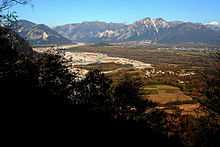

Rivers flowing southwards from the mountains are numerous. The Friulian mountains surround the course of the Tagliamento river, which, at the latitude of Gemona del Friuli first crosses the hills that occupy the center of the Friuli, then flows into a large flood plain. This plain is commonly divided into the High Friulian plain and the Low Friulian plain (Bassa Friulana), whose boundary is the Napoleonic road that connects the cities of Codroipo and Palmanova. To the south of this road is the risorgive zone, where water resurfaces from underground waterways in spring-fed pools throughout the area. South of the plains lie the lagoons of Marano and Grado, which are nature reserves. Other important rivers include the Torre, Natisone, Stella, Isonzo/Soča, and Ausa.
Friuli covers an area of 8,240 square kilometres (3,180 sq mi), subdivided among the provinces of Udine 4,905 square kilometres (1,894 sq mi), Pordenone 2,178 square kilometres (841 sq mi) and Gorizia 466 square kilometres (180 sq mi). The historical capital and most important city of is Udine, it was also the capital of the medieval Patria del Friuli. Other important towns are Pordenone, Gorizia/Nova Gorica, Sacile, Codroipo, Cervignano del Friuli, Cividale del Friuli, Gemona del Friuli, Monfalcone, and Tolmezzo.
Climate
The climate of the Friulian plain is humid sub-Mediterranean. The climate in this area is suitable for growing white wine grapes, and 2.5% of wine produced in Italy comes from this part of the region.[1] The hills, however, have a continental climate, and the mountainous regions have an alpine climate. On the coast the mean annual temperature is 14 °C (57 °F), while in the inner plains, the average is lowered to 13 °C (55 °F) - 13.5 °C (56.3 °F) (Udine 13.1 °C (55.6 °F), Pordenone 13.3 °C (55.9 °F), Gorizia 13.4 °C (56.1 °F)). Further north, in Tolmezzo, the average temperature is approximately 10.6 °C (51.1 °F). The lowest values are recorded in the Alps: 4 °C (39 °F) at Passo di Monte Croce Carnico (1,300 metres (4,300 ft)) and between 5.5 °C (41.9 °F) and 7 °C (45 °F) in Val Canale, which is situated 850 metres (2,790 ft) above sea level. In the coldest month, January, temperatures vary between approximately 4.5 °C (40.1 °F) in Monfalcone and nearly −5 °C (23 °F) in Passo di Monte Croce Carnico, with intermediate temperatures of 3 °C (37 °F) in Udine and −2 °C (28 °F) or −3 °C (27 °F)in Valcanale. Gorizia, a short distance from Udine, enjoys a particularly milder micro-climate with its approximate annual average of 4 °C (39 °F). In the warmest month, July, the temperatures range between 22.5 °C (72.5 °F) - 24 °C (75 °F) along the coast and plains and the 14 °C (57 °F) - 16 °C (61 °F) in Val Canale.
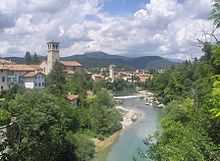
Precipitation in Friuli is relatively abundant; the distribution of rainfall varies a great deal during the course of the year. Minimum values in the southern part generally fall between 1,200 millimetres (47 in) and 1,500 millimetres (59 in) (Gorizia over 1,350 millimetres (53 in) and Udine over 1,400 millimetres (55 in)), whereas the alpine area's maximum annual rainfall is approximately 3,000 millimetres (120 in). The Julian Prealps is one of Italy's rainiest regions: Musi receives about 3,300 millimetres (130 in) of annual precipitation and can receive 400 millimetres (16 in) in a single month. In some areas of Friuli, excessive rainfall has caused erosion and the flooding of many rivers. Snow is sparse in the southern plains (3 or 4 snowy days each year in Udine and Pordenone) but falls more consistently further to the north (Val Canale 25 days, Sauris 23 days, and Passo di Monte Croce Carnico 28 days).
Demography
Friuli's a little under one million people. It must be considered also that Mandament of Portogruaro and comune of Sappada historically belong to Friuli. With these lands, the total population reaches 1.060.000 people (~94.000 more).
| Zona | Population (2005) | Land Area (km²) |
Population Density (inh./km²) |
|---|---|---|---|
| Province of Gorizia | 140,681 | 466 | 302 |
| Province of Udine | 528,246 | 4,905 | 108 |
| Province of Pordenone | 297,699 | 2,178 | 137 |
| Total | 966,626 | 7,549 | 128 |
One of the most important demographic phenomena in Friuli was emigration. It began in the final decades of the 19th century and ended in the 1970s. It is estimated that more than a million Friulian people emigrated away over a period of approximately one hundred years. According to the most recent census by AIRE (2005), Friulian émigrés living abroad number 134,936. Of these, 56.0% reside in Europe, 24.0% in South America, 10.3% in North America and 4.7% in Oceania. This data only reflects those Friulians and their descendants who have Italian citizenship. The descendants of Friulians are excluded from the census because they are not Italian citizens. Friulians in the world have supported cultural associations called Fogolârs furlans, of which there are 46 in Italy and 156 in the rest of the world.
Ente Friuli nel Mondo (Friuli in the World)
In 1953, to assist Friulians in foreign countries and to coordinate the activities of the Fogolârs Furlans, the organization Ente Friuli nel Mondo (Friulians in the World), was founded. It publishes a magazine, Friuli nel Mondo, and 25,000 copies are distributed in 78 different countries. The organization educates émigrés and their descendants about their origins, ethnic identity, and maintains connections among Friulians around the world.
History
Origins and the Roman age

In the prehistoric era, Friuli was home to the Castellieri culture. These peoples most likely arrived from the sea and were the dominant culture in the area from about the 15th century BCE until the early historical period. During the course of the 4th century BC the Carni (in ancient greek Καρνίοι), a tribe of unknown ethnicity which may have spoken a Celtic, a Venetic or a Rhaetic language, and who introduced advanced techniques of working iron and silver settled Friuli. According to Strabo [4.6] the Carni inhabited "the country about the Adriatic Gulf and Aquileia" and both Pliny [3.22(18)] and Ptolemy [3.1] ascribe Aquileia, Concordia and Forum Julii to belong to the "towns of the Carni" in the "country of the Carni". The Carni worshiped the deity Belenus which is attested by the most numerous votive inscriptions found in and around Aquileia.[2] Beginning from the 2nd century BC, Friuli was colonized by the Romans: Aquileia was the fourth largest city of Italy during Roman imperial times, capital of Regio X of the Italia province (the Augustan region Venetia et Histria). The city was the most important river port on the Natissa river, dominating trade between the Adriatic Sea and northern Europe (carried over the Via Iulia Augusta road). A northern mountainous area of Friuli still retains the ancient name Carnia.
Aquileia owed its importance to the strategic position it has on the Adriatic sea and its proximity to the Alps. This location allowing Rome to intercept barbarian invasions from the East. Julius Caesar quartered his legions in Aquileia during winter. The development of other centers, such as Forum Iulii (Cividale del Friuli) and Iulium Carnicum (Zuglio), contributed to the increase in economic and cultural wealth of Friuli until the first barbarian incursions, at the beginning of 5th century. In the final decades of the 3rd century, Aquileia became the center of one of the most prestigious bishoprics of the empire, competing in Italy with Milan and, subsequently, Ravenna, for second place to Rome. A Hun invasion marked the start of Friuli's decline: Aquileia, protected by meager forces, was forced to surrender and was razed to the ground by Attila in 452. After the retreat of the Huns, the survivors, who had found shelter in the lagoon of Grado, returned to the city, but found it completely destroyed. The reconstruction of Aquileia was never completed and it never regained the old splendour of the capital of X Regio. The city remained important even after the fall of the Western Roman Empire, due to the creation of the Patriarchate of Aquileia. It ranked among the highest ecclesiastic authorities in Italy from the mid-6th century onward. The lack of security in the Friulian plain, crossroads of all the great barbarian invasions, drove many people to seek shelter on the islands of the lagoons or in fortified hill-villages, causing a generalized depopulation of the more fertile part of the region and its consequent impoverishment.
Middle Ages
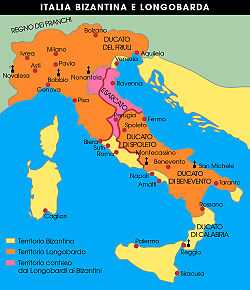
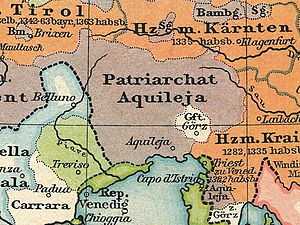
After the collapse of the Western Roman Empire, Friuli belonged to the kingdom of Odoacer and subsequently to that of Theodoric the Great. The Byzantine reconquest under Justinian I was brief in the region, in 568 it was one of the first provinces conquered by the Lombards, who invaded from Pannonia, and with that, ended the Greek-Byzantine era of the region. The Lombard king Alboin established the Duchy of Friuli, the first Lombard duchy, and granted it to his relative Gisulf I. The capital of the duchy was established at Forum Iulii (Cividale del Friuli), which became the most important city of the area and for where it derived its name.
The duchy of Friuli was from the start one of the most important Lombard duchies. It served as a barrier against the threat of invasion by the Avars and Slavs from Pannonia. Among the duchies of the North, which were closely aligned with the crown (unlike Spoleto and Benevento to the South), it was the most powerful, probably due to its marcher status. Among later dukes, Ratchis became king in 744 and his ducal successor, Aistulf, succeeded him as king in 749. The historian Paul the Deacon was born in Friuli (730/5), he went on to write the Historia Langobardorum and taught Latin grammar at Charlemagne's court. Another teacher and a trusted advisor Charlemagne's court, Paulinus, was born at Cividale and eventually became patriarch of Aquileia.
After the Regnum Italiae fell to the Franks, the duchy of Friuli was reorganized into counties according to the Frankish model. The region was again reorganized into the March of Friuli in 846. The march was granted to the Unruoching dynasty. Friuli became the base of power of Berengar I during his struggles for the throne of Italy between 888 and 924.
The march was transformed under his rule, its territory extended to Lake Garda, the capital moved to Verona, and a new March of Verona and Aquileia established in its place. The territory was now subjected to the Duchy of Bavaria, then to the Duchy of Carinthia, for more than a century.
On 3 April 1077, the Emperor Henry IV granted the county of Friuli, with ducal status, to Sigaerd, Patriarch of Aquileia. In the succeeding centuries, the patriarchate expanded its control over neighboring Trieste, Istria, Carinthia, Styria, and Cadore. The patriarchal state of Friuli was one of the best organized polities of the Italian Middle Ages. From the 12th century it possessed a parliament representing the communes as well as the nobility and the clergy. This institution only survived six centuries, remaining alive yet weak even during Venetian domination. It convened for the last time in 1805, when it was abolished by Napoleon Bonaparte. The Patriarch Marquardo of Randeck (1365–1381) had gathered together and codified all the laws of Friuli and promulgated them as the Constitutiones Patriae Foriiulii ("Constitutions of the Country of Friuli"). Cividale del Friuli was seat of the Patriarchate until 1238, when the patriarch moved his seat to Udine, where he had a magnificent episcopal edifice constructed. Udine was so important that it in time became the institutional capital of Friuli.
Venetian domination to Bourbon Restoration
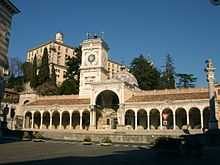
The Patriarchy ended in 1420: surrounded by the powerful states of the Austrian Empire, the Kingdom of Hungary and the Venetian Republic, it was the theatre of the war between Hungary and Venice, and was conquered by the latter. Friuli maintained some form of autonomy, by keeping its own Parliament ruling on the old territory of the Patriarchate, an autonomy not granted to the other cities and provinces submitted to Venice (even Venetian ones); on the other side, it maintained also its feudal nobility, which was able to keep their feudal rights over the land and its inhabitants for some time.
Friuli was the eastern border of the Stato da Tera, and suffered both from the Turkish raids and from the border wars with Austria. These wars led to poverty and instability of the rural population, with the inability to cultivate the land crossed by fighting armies and with the forced surrender of all livestock to feed traveling troops. The lumber needed to build Venetian ships caused complete deforestation of the Bassa Friulana and central Friuli. Venice took possession of collective farms belonging to rural Friulian communities and seriously impoverishing them. These properties in turn would be sold by Venice during the 17th century to raise cash to alleviate their poor financial condition.
Beginning in the 1630s the Venetian Republic entered a relative decline, due to the enlarging horizon of European markets (going now from Asia to Africa to Americas); Venetian richest families often directed financial resources into unproductive investments (specifically real estate), while there was a loss of competitiveness in industries and services. Friuli was subject to increasingly fiscal pressure and its industries and commercial activities were affected too.

The political populism practiced by Venice, according to some historians, looked for ways to limit the most oppressive and anachronistic effects of feudalism. Other researchers affirm that the Venetian aristocratic government maintained a most oppressive feudal condition in Friuli. These policies were practiced by the Venetian government to ensure the support of the urban and rural population as a counterbalance to the independent tendencies and power of local oligarchies and aristocrats.
An important jacquerie, known as Joibe Grasse 1511 (Fat Thursday 1511), was started in Udine on February 27 by starving Udinesi citizens. They were subsequently joined by the farmers and the revolt spread to the whole territory of Friûl, against the feudal rule of some noble families; some other noble family, like the pro-Venetian Savorgnan, initially supported the revolters. This insurrection was one of the largest in Renaissance Italy and it lasted from 27 February until March 1, when it ended as Venice dispatched around one hundred cavalry to put down the rebellion. The chiefs of the revolt were executed, but the feudal powers of the Friulian noblemen were reduced.
With the 1516 Noyon pacts the boundary between the Venetian Republic and the County of Gorizia and Gradisca, now in the hands of the House of Habsburg, were redefined. Venice lost the upper Isonzo valley (that is the Gastaldia of Tolmino with Plezzo and Idria), but it kept Monfalcone, Marano and a series of shed feudal islands in the Western Friuli stayed with the Archduke of Austria (until 1543). Between 1615 and 1617 Venice and Austria again fought for the possession of the fort of Gradisca d'Isonzo. The so-called War of Gradisca ended with a return to the status quo.
Beginning in 1516 the Habsburg Empire controlled eastern Friuli, while western and central Friuli was Venetian. In 1797, the year of the Treaty of Campo Formio, this part of the Friuli was surrendered to Austria. For a brief period from 1805 until the Bourbon Restoration, Friuli belonged to the Italic Kingdom.
Contemporary history
From the Restoration to the Great War
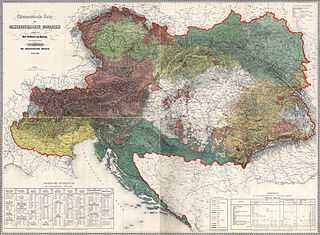
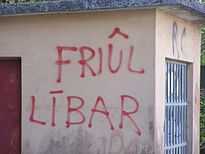
In 1815, the Congress of Vienna confirmed the union of Veneto, which Central-West Friuli was part of, with Lombardy (previously divided between Austrian Empire and Venetian Republic), to constitute the Kingdom of Lombardy-Venetia. Eastern Friuli was not included in the puppet state. In 1838, the District of Portogruaro was removed from the Province of the Friuli due to the Austrians' wishes and assigned to the Province of Venice. Portogruaro was for long time part of Friuli, even under Venetian Republic, and Friulian language was spoken in the area. In 1866, central Friuli (today's province of Udine) and western Friuli (today's province of Pordenone) were annexed by Italy together with Veneto after the Third Italian War of Independence, while eastern Friuli (County of Gorizia and Gradisca) remained under Austria until the end of World War I.
The Ethnographic map of Karl von Czoernig-Czernhausen, issued by the k. u. k. Administration of Statistics in 1855, recorded a total of 401,357 Friulians living in the Austrian Empire. The majority of Friulians [351,805] lived in that part of Friuli that belonged to the Kingdom of Lombardy-Venetia, the others [49.552] in the Friulian parts of the Austrian Küstenland. Friulians were registered as their own category separate from Italians.
During World War I, Friuli was a theater of battle that had serious consequences for the civilian population, specifically the Battle of Caporetto.
Autonomist movements
Friuli has a large number of Friulan native speakers that still keep their native culture. There are some movements and political parties that advocate a more autonomous, or even an independent Friuli in line with historical borders, such as the Lega Nord Friuli-Venezia Giulia, Friuli Movement and the Front Furlan.
Regional languages and dialects
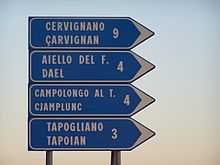
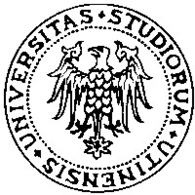
While standard Italian is the primary official language of the region, several other regional languages and dialects are spoken in Friuli.
Friulian is spoken in the provinces of Udine, Gorizia, and Pordenone.
Venetian and its dialects are usually spoken (for historical reasons) on the western border regions (i.e. Pordenone), sparingly in a few internal towns (i.e. Gorizia, etc.), and historically in some places along the Adriatic coast.
In the southeastern part of Friuli, a Venetian transitional dialect is spoken, called Bisiaco, that has influences of both Slovene and Friulian.
Slovene dialects are spoken in the largely rural border mountain region known as Venetian Slovenia. German (Bavarian dialect) is spoken in Val Canale (mostly in Tarvisio and Pontebba); in some of Val Canale's municipalities (particularly in Malborghetto Valbruna), Carinthian Slovenian dialects are spoken too. Slovene is also spoken in the Collio area north of Gorizia. In the Resia valley, between Venetian Slovenia and the Val Canale, most of the inhabitants still speak an archaic dialect of Slovene, known as Resian. According to the official estimates of the Italian government, between 45,000 and 51,000 Slovene speakers live in Friuli: around 11,000 in the Province of Gorizia, and the rest in the Province of Udine.[3] Due to emigration, most Slovene speakers in the Province of Udine live outside their traditional compact zone of settlement.[3]
German-related dialects are spoken in several ancient enclaves like Timau, Zahre (Sauris) and Plodn (Sappada).
Note: only Friulian, Slovenian and German are allowed to be local secondary official languages in their historic areas, but not their related dialects.
See also
- Benandanti
- Furlanis
- List of dukes and margraves of Friuli
- List of Friulian place names
- Triveneto
- Venetian Slovenia
References
- ↑ "Friuli White Wines: Refreshing (and Sometimes Quirky)". IntoWine.com.
- ↑ Maier, Bernhard (2000). Die Kelten. Ulm. p. 119.
- ↑ 3.0 3.1 Prof. Samo Pahor: "Koliko je Slovencev v Italiji?"
External links
| Wikimedia Commons has media related to Friuli. |
- Autonomous Region of Friuli Venezia Giulia
- Official regional tourism agency of FVG
- Friulan gastronomy
- FVG international Airport
- Italian Language School in Friuli
| ||||||||||||||||||||||||||||

